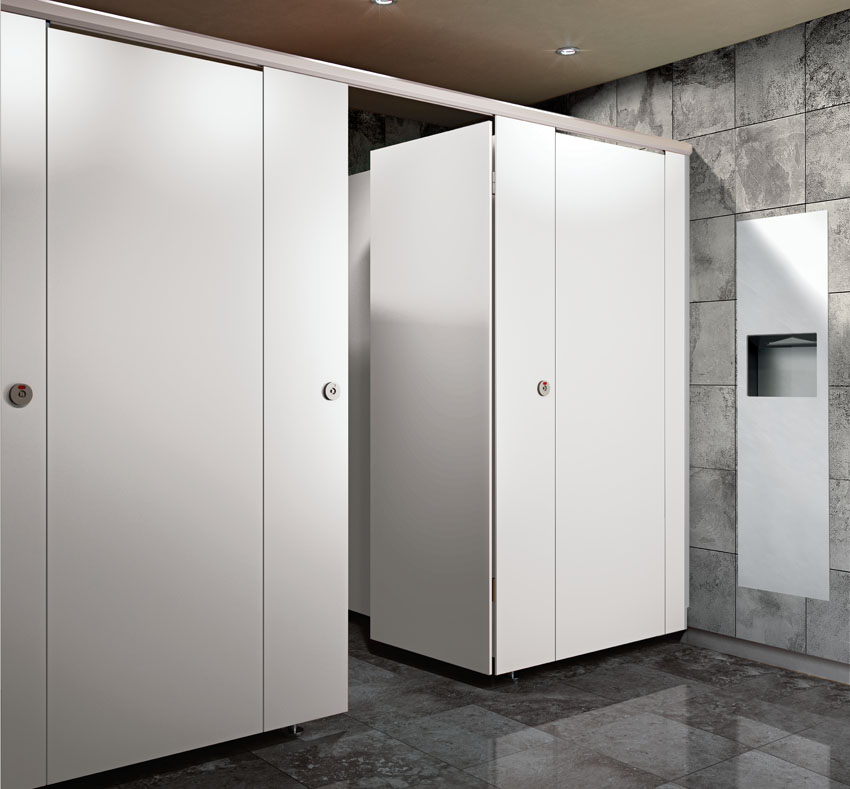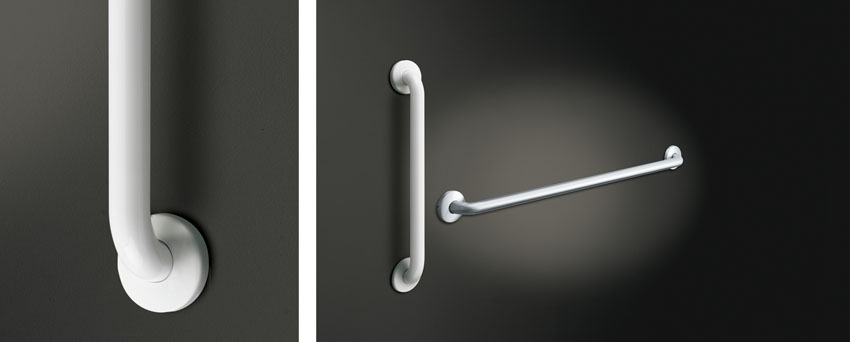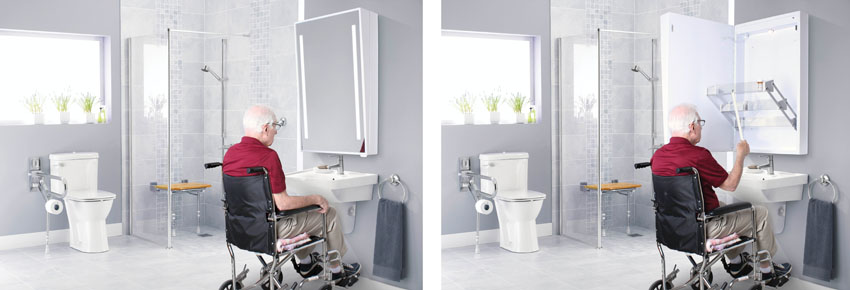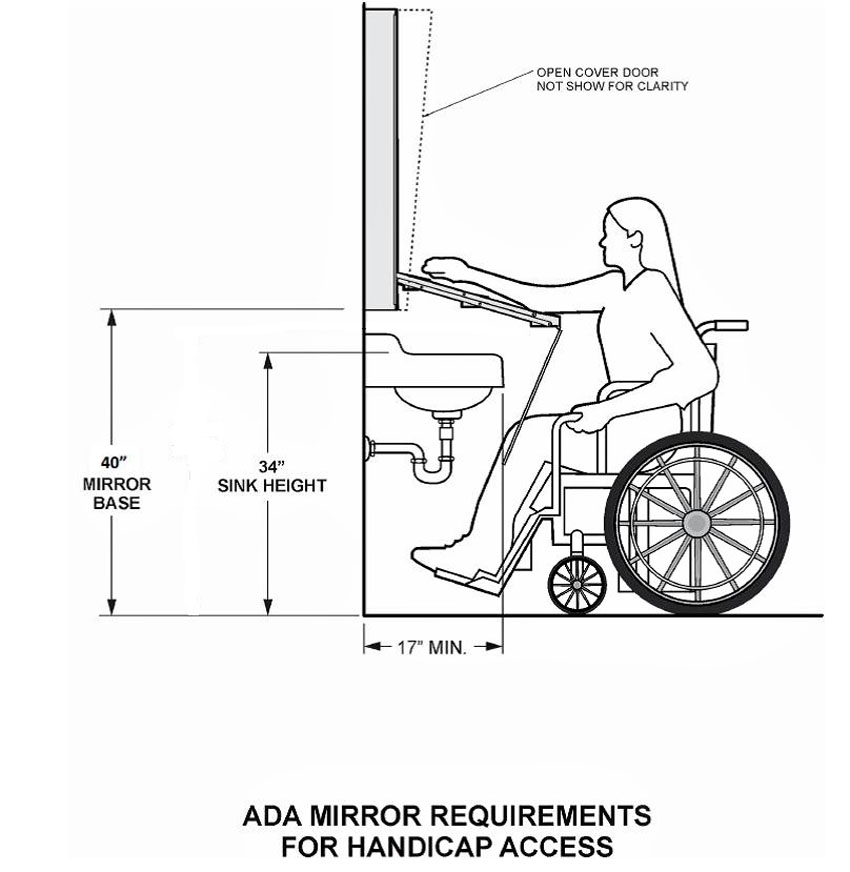Healing Environments for Health Care
Hygienic Partitions and Lockers
Group restrooms and locker rooms typically contain partitions that need to address a variety of conditions. Toilet-stall partitions first need to address privacy, which some do better than others. Partitions are now available that have zero sightlines into the stalls and create a more safe feeling with regard to the bathroom experience. Many different partition heights are now available, allowing stall partitions to be much closer to the floor for increased privacy.

Photo Courtesy of ASI
Restroom partitions are available in more appealing materials and finishes that can also be specified as taller to provide more privacy.
There are a variety of materials that can be selected for partitions that also address appearance, functionality, hygiene, and durability. Plastic or phenolic products are particularly appropriate for very wet/humid environments like locker rooms, shower areas, etc. Powder-coated steel or stainless steel has also been successfully used for common areas where water and humidity are less of a concern. Of course, since there is a desire to move away from cold, institutional appearances, such partitions need to provide an appropriate aesthetic. Plastic laminate partitions have been used as a cost-effective solution for this type of application, but they need to be properly selected and specified in order to avoid delamination or other problems. Toward that end, at least one manufacturer offers an edge-banding system (often the common weak point in the finish) that fuses with the substrate, creating a seamless beveled profile that eliminates any unsightly black lines that normally appear in standard plastic laminate. ASTM tests on this type of system confirm up to three times greater durability with increased resistance to moisture and humidity than standard plastic laminate. From a design standpoint, the edge banding is available in more than 45 different colors and patterns to match laminate on partition doors, panels, and pilasters.
Antimicrobial Grab Bars

Photo Courtesy of ASI
Stainless-steel grab bars coated with an antimicrobial powder coating have been shown to be effective at reducing the number of certain microbes that can spread desease and infection in health-care facilities.
Many things in health-care restrooms, showers, and similar areas are designed to be “touchless” to help avoid the transfer of germs and bacteria between people. However, grab bars used around plumbing fixtures need, by definition, to be touched—and tightly. While routine and frequent washing/cleaning of such grab bars is usually undertaken, there is also the option of specifying antimicrobial products to help reduce the spread of microbes such as mold, bacteria, and yeasts. These microbes can grow quickly in warm, moist environments such as health-care facilities and have been attributed to a number of hospital-acquired diseases.
Antimicrobial grab bars, made of stainless steel, or galvanealed steel, are available that are finished with an antimicrobial powder coating. The powder coating is formulated to incorporate the slow release of antimicrobial agents like silver ions (Ag+). The antimicrobial agents are not topical because they are impregnated into the powder before it is electrostatically fused with the metal grab bars—and this increases their effective lifetime. In these coatings, the silver ions are the active agent that imparts antimicrobial properties into the surface. When the coating on the grab bar comes into contact with moisture, silver ions are released to the surface. Those ions penetrate the cell membrane of microbes present on the surface and create a reaction within the organism, which renders it inactive.
Lab tests have shown a significant decrease in the number of living bacteria found on the antimicrobial surface in a 24-hour period, with a documented bacterial kill rate of greater than 99.95 percent. Under similar circumstances, the number of living bacteria present on a surface that is not treated with antimicrobial agents grows exponentially. Antimicrobial grab bars can be used in any location where hygiene and infection control are of the utmost importance. Common applications include hospitals, doctor offices, senior and assisted living communities, and mental health facilities.
RESTROOM ACCESSIBILITY
Beyond the basic functionality and appearance of restrooms in health-care facilities, there is clear indication to address accessibility needs for patients and visitors. Since there is a higher likelihood of accommodating elderly and/or disabled people in these buildings, the need for proper attention to all aspects of accessibility is heightened. Plumbing fixtures and controls are all readily available to be specified with the appropriate accessibility features provided by the manufacturers, and that is routinely done. However, there are other aspects of restrooms and residential health-care facilities that need to be addressed by the design professionals involved. In particular, there has been a design emphasis placed on allowing people to remain independent when performing some common functions or activities in bathrooms. While many people reference the civil rights legislation known as the Americans with Disabilities Act (ADA) as the standard for this type of independent accessible design, in fact, architects are bound by the code standard ICC ANSI 117.1: Accessible and Usable Buildings and Facilities. Fortunately, in recent years, these two standards agree on most of the language and details related to building construction. (There are some minor differences, but the ADA covers things beyond construction too). For our purposes though, we will refer simply to ICC ANSI 117.1 as it applies to some specific bathroom issues.
Accessible Medicine Storage
People who need health care usually need medications. If someone is also wheelchair bound, then being able to access that medicine or other health-related items (bandages, lotions, toiletries, etc.) needs to be thought through. Many people would store such items in a medicine cabinet over a sink, but if that is beyond reach in a wheelchair, then it clearly will not work—so what does?
Identifying Standards
ICC ANSI 117.1 addresses sinks and wheelchair accessibility pretty thoroughly. It also addresses high and low reaching heights from a wheelchair and differentiates between unobstructed and obstructed reaching conditions. In the case of a medicine cabinet over a sink, an obstructed situation is created. The 117.1 standard defines that obstruction since it defines the parameters for the sink in Section 606: Lavatories and Sinks. First, the required clear space in front of the sink is defined based on Section 305 and a forward approach, meaning that the person in a wheelchair is able to reach forward to access the sink. The sink itself is required to be no higher than 34 inches from the floor. An enhanced reach range is acknowledged if the sink is no more than 11 inches deep. If a more standard condition occurs where the sink is in a countertop that is approximately 17 to 24 inches deep, then the reach range is not considered to be enhanced.

Photos courtesy of Aamsco Lighting, Inc.
An innovative, accessible, illuminated, and mirrored medicine chest allows a wheelchair user to independently access medications and toiletries.
In terms of reaching something above the sink, Section 308: Reach Ranges is the applicable part of the 117.1 standard. Section 308.2.2 related to Obstructed High Reach points out that “the clear floor space complying with Section 305 shall extend beneath the element…” thus allowing full access by pulling forward to reach the wall above the sink. It goes on to indicate that there are two different high forward-reach height limits: a 48-inch maximum above the floor applies where the reach depth is 20 inches or less, while 44 inches is the maximum reach height if the depth exceeds 20 inches but up to a maximum of 25 inches.
In the case of providing an accessible medicine cabinet over a sink, then, the standard dictates that the bottom of that cabinet (and the access to anything in it) must fall between 34 inches above the floor (maximum sink height) and either 44 or 48 inches above the floor depending on the depth of the sink/counter. Where a mirror is on the face of the medicine cabinet, the bottom of the mirror is dictated in the 117.1 Standard in Section 603.3: Mirrors. In this case, it requires it to “be mounted with the bottom edge of the reflecting surface 40 inches maximum above the floor.” This simply places the mirrored surface a bit closer to the sink height but does not change the maximum reaching height inside the medicine cabinet.

Image courtesy of Aamsco Lighting, Inc.
Maximum reaching height from a wheelchair is governed by the depth of a sink or other obstruction between the person and the wall.
Notice

www.aamsco.com/mirrors/wheelchair-medicine-chest


www.inpro.com

www.kohler.com

www.lonseal.com

www.waclighting.com









